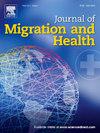意大利和移民居民死亡率的社会经济不平等:一项基于人口的纵向研究
IF 2.9
Q1 PUBLIC, ENVIRONMENTAL & OCCUPATIONAL HEALTH
引用次数: 0
摘要
高移徙压力(HMPCs)和包括意大利在内的高度发达国家的社会经济死亡率梯度有利于最有利的社会群体。然而,关于这种联系在本地人和移民之间有何不同,人们知之甚少。本研究旨在评估意大利及移民居民的教育水平、职业阶层与死亡率之间的关系。方法采用纵向设计,对2011年意大利人口普查人口进行随访至2019年。通过与死亡原因登记册的记录链接检索全因死亡率。在30-64岁的受试者中,分别按性别、国籍/宏观原籍地区评估教育/职业等级与死亡率之间的关系。使用负二项回归模型估计死亡率比(MRR)和95%置信区间。结果在分析的23,572,516名受试者中,7%是来自HMPCs的移民;在410,746例死亡中,3%来自HMPCs。意大利人受教育程度不同,死亡率呈梯度(低/高adjMRR:男性2.37 [2.16-2.60];女性为1.79[1.64-1.96],而HMPC移民的相关性较弱,没有趋势(adjMRR: 1.12 [1.00-1.25];1.12[1.00-1.26]女性)。就职业类别而言,来自HMPCs的移民中,男性“农民”和“不活动”的死亡率高于“非体力劳动者”(adjMRR分别= 1.31[1.06-1.61]和adjMRR = 1.67 [1.50-1.85]);女性为“不活跃”受试者(adjMRR = 1.48[1.35-1.62])。罗马尼亚、印度和中国的男性,以及中东欧、撒哈拉以南非洲和中南美洲的女性,受教育程度较低的人死亡率较高。摩洛哥受教育程度最低的人死亡率较低。结论受教育程度较低的意大利人的死亡率较高,而来自HMPCs的移民的死亡率较低。然而,在公民身份、宏观原籍地区和性别之间观察到的差异突出表明,需要制定考虑到影响正确生活方式和获得保健服务的具体风险因素和文化特点的社会政策。本文章由计算机程序翻译,如有差异,请以英文原文为准。
Socioeconomic inequalities in mortality among Italian and immigrant residents: A longitudinal population-based study
Background
A socioeconomic mortality gradient, favourable to the most advantaged social groups, has been documented in high migratory pressure (HMPCs) and highly developed countries, including Italy. However, little is known about how this association differs between natives and immigrants. This study aimed to evaluate the association between education level, occupational class and mortality among Italian and immigrant residents.
Methods
Using a longitudinal design, the 2011 Italian Census population was followed up to 2019. All-cause mortality was retrieved by record linkage with the Causes of Death register. The association between education/occupational class and mortality was evaluated in subjects aged 30–64, separately by sex, citizenship/macro area of origin. Mortality rate ratios (MRR) and 95 % confidence intervals were estimated using negative binomial regression models.
Results
Of the 23,572,516 subjects analysed, 7 % were immigrants from HMPCs; of the 410,746 deaths, 3 % were from HMPCs. Among Italians, a mortality gradient by education was observed (low/high adjMRR: 2.37 [2.16–2.60] males; 1.79 [1.64–1.96] females), whereas a weaker association with no trend was found for HMPC immigrants (adjMRR: 1.12 [1.00–1.25] males; 1.12 [1.00–1.26] females). Regarding occupational class, for immigrants from HMPCs, a higher mortality was observed in male “farmers” and “inactives” compared to “non-manual workers” (adjMRR = 1.31 [1.06–1.61] and adjMRR = 1.67 [1.50–1.85], respectively); and in females for “inactive” subjects (adjMRR = 1.48 [1.35–1.62]).
A higher mortality for the less educated was observed for males from Romania, India and China, and for females from Central-Eastern Europe, Sub-Saharan Africa and Central and South America. A lower mortality was found for the least educated from Morocco.
Conclusions
The higher mortality among less educated subjects was confirmed among Italians, while it was less evident among immigrants from HMPCs. However, differences observed between citizenships, macro-areas of origin and sex highlight the need for social policies accounting for specific risk factors and cultural specificities affecting correct lifestyles and health service access.
求助全文
通过发布文献求助,成功后即可免费获取论文全文。
去求助
来源期刊

Journal of Migration and Health
Social Sciences-Sociology and Political Science
CiteScore
5.70
自引率
8.70%
发文量
65
审稿时长
153 days
 求助内容:
求助内容: 应助结果提醒方式:
应助结果提醒方式:


